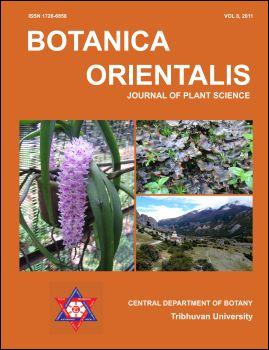Response of plant species to abandonment of subalpine fields, Manang, Nepal
DOI:
https://doi.org/10.3126/botor.v8i0.5553Keywords:
abundance value, oldfields, secondary succession, stages of succession, trans-HimalayasAbstract
Spatial dimension of abandoned fields has been expanding more in rural subalpine zones of Nepal leading to various patterns of secondary succession. The secondary succession in the subalpine Himalayas has not yet been evaluated. Here, I describe a study initiated in Manang district, Central Nepal where enough abandoned fields of different chronosequences were located. A definitive successional pattern was predicted from the data obtained from sampling 256 plots of 1 × 1 m2 each systematically in a total of 43 abandoned fields from 1 to 55 years after abandonment. Change in composition pattern of 11 most important plant species was analyzed through the Detrended Correspondence Analysis (DCA). The first two axes of DCA explained 19.1 % of the total variation in the species composition. Early, mid and late successions were three stages distinguished each by their abundance scores and life-forms composition. Malva neglecta, Phleum alpinum and Fagopyrum esculentum were dominant at the recently abandoned fields. Cynoglossum zeylanicum, Malaxis muscifera, Medicago falcata and Pennisetum flaccidum were mid succession species, and Thymus linearis, Tanacetum gossypinum, Pinus wallichiana and Poa annua represented the late succession species.
doi: http://dx.doi.org/10.3126/botor.v8i0.5553
Botanica Orientalis – Journal of Plant Science (2011) 8: 10-15
Downloads
Downloads
Published
How to Cite
Issue
Section
License
This license enables reusers to copy and distribute the material in any medium or format in unadapted form only, for noncommercial purposes only, and only so long as attribution is given to the creator.




